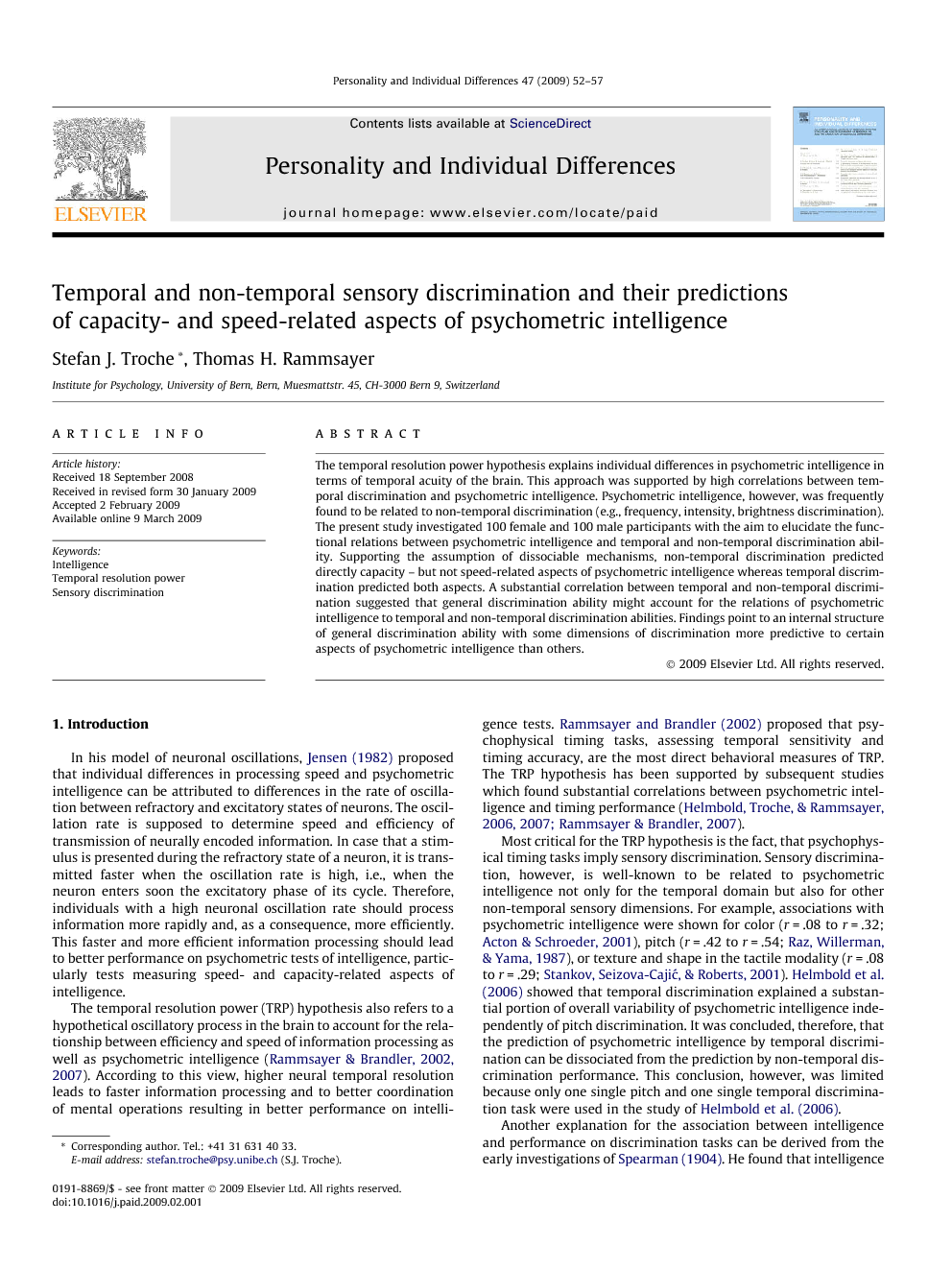The temporal resolution power hypothesis explains individual differences in psychometric intelligence in terms of temporal acuity of the brain. This approach was supported by high correlations between temporal discrimination and psychometric intelligence. Psychometric intelligence, however, was frequently found to be related to non-temporal discrimination (e.g., frequency, intensity, brightness discrimination). The present study investigated 100 female and 100 male participants with the aim to elucidate the functional relations between psychometric intelligence and temporal and non-temporal discrimination ability. Supporting the assumption of dissociable mechanisms, non-temporal discrimination predicted directly capacity – but not speed-related aspects of psychometric intelligence whereas temporal discrimination predicted both aspects. A substantial correlation between temporal and non-temporal discrimination suggested that general discrimination ability might account for the relations of psychometric intelligence to temporal and non-temporal discrimination abilities. Findings point to an internal structure of general discrimination ability with some dimensions of discrimination more predictive to certain aspects of psychometric intelligence than others.
In his model of neuronal oscillations, Jensen (1982) proposed that individual differences in processing speed and psychometric intelligence can be attributed to differences in the rate of oscillation between refractory and excitatory states of neurons. The oscillation rate is supposed to determine speed and efficiency of transmission of neurally encoded information. In case that a stimulus is presented during the refractory state of a neuron, it is transmitted faster when the oscillation rate is high, i.e., when the neuron enters soon the excitatory phase of its cycle. Therefore, individuals with a high neuronal oscillation rate should process information more rapidly and, as a consequence, more efficiently. This faster and more efficient information processing should lead to better performance on psychometric tests of intelligence, particularly tests measuring speed- and capacity-related aspects of intelligence.
The temporal resolution power (TRP) hypothesis also refers to a hypothetical oscillatory process in the brain to account for the relationship between efficiency and speed of information processing as well as psychometric intelligence (Rammsayer and Brandler, 2002 and Rammsayer and Brandler, 2007). According to this view, higher neural temporal resolution leads to faster information processing and to better coordination of mental operations resulting in better performance on intelligence tests. Rammsayer and Brandler (2002) proposed that psychophysical timing tasks, assessing temporal sensitivity and timing accuracy, are the most direct behavioral measures of TRP. The TRP hypothesis has been supported by subsequent studies which found substantial correlations between psychometric intelligence and timing performance (Helmbold et al., 2006, Helmbold et al., 2007 and Rammsayer and Brandler, 2007).
Most critical for the TRP hypothesis is the fact, that psychophysical timing tasks imply sensory discrimination. Sensory discrimination, however, is well-known to be related to psychometric intelligence not only for the temporal domain but also for other non-temporal sensory dimensions. For example, associations with psychometric intelligence were shown for color (r = .08 to r = .32; Acton & Schroeder, 2001), pitch (r = .42 to r = .54; Raz, Willerman, & Yama, 1987), or texture and shape in the tactile modality (r = .08 to r = .29; Stankov, Seizova-Cajić, & Roberts, 2001). Helmbold et al. (2006) showed that temporal discrimination explained a substantial portion of overall variability of psychometric intelligence independently of pitch discrimination. It was concluded, therefore, that the prediction of psychometric intelligence by temporal discrimination can be dissociated from the prediction by non-temporal discrimination performance. This conclusion, however, was limited because only one single pitch and one single temporal discrimination task were used in the study of Helmbold et al. (2006).
Another explanation for the association between intelligence and performance on discrimination tasks can be derived from the early investigations of Spearman (1904). He found that intelligence was almost perfectly related to a battery of discrimination tasks of different dimensions (e.g., pitch, weight and brightness) suggesting a functional relationship between unspecific, general discrimination ability (GDA) and intelligence. More recently, this finding was replicated by Deary, Bell, Bell, Campbell, and Fazal (2004) who reported a relation of r = .92 between GDA and intelligence. From this perspective, the association between dimension-specific discrimination performance and psychometric intelligence can also be explained by the relation between GDA and psychometric intelligence. Proceeding from this assumption, GDA may also account for the observed relation between TRP and psychometric intelligence. Hence, the question arises whether the association between psychometric intelligence and temporal acuity reflects directly a time-specific neural property as suggested by the TRP hypothesis or whether it must be attributed primarily to the more general functional relationship between mental ability and GDA.
The aim of the present study was to compare two theoretical models (see Fig. 1). The first model expanded the investigation of Helmbold et al. (2006) to the level of latent variables by factorizing various non-temporal and temporal discrimination tasks. It is assumed that temporal and non-temporal discrimination abilities predict psychometric intelligence as two dissociable factors which, however, can be related to each other. The TRP hypothesis postulates that TRP affects both capacity- and speed-related aspects of psychometric intelligence (Helmbold & Rammsayer, 2006). Although theoretically unexplained, non-temporal discrimination was empirically found to be related to capacity- (Deary et al., 2004, Raz et al., 1987 and Stankov et al., 2001) and speed-related aspects (Roberts, Stankov, Pallier, & Dolph, 1997). Therefore, the relations between temporal and non-temporal discrimination performances, on one hand, and capacity – as well as speed-related aspects of psychometric intelligence, on the other, were investigated concomitantly in the present study.


